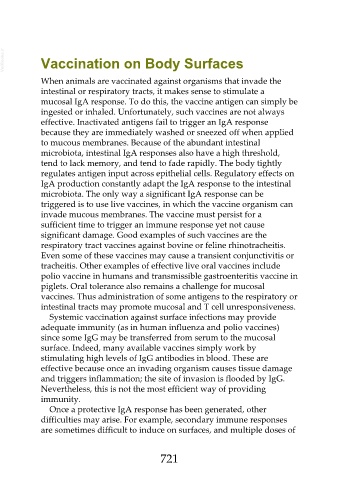Page 721 - Veterinary Immunology, 10th Edition
P. 721
VetBooks.ir Vaccination on Body Surfaces
When animals are vaccinated against organisms that invade the
intestinal or respiratory tracts, it makes sense to stimulate a
mucosal IgA response. To do this, the vaccine antigen can simply be
ingested or inhaled. Unfortunately, such vaccines are not always
effective. Inactivated antigens fail to trigger an IgA response
because they are immediately washed or sneezed off when applied
to mucous membranes. Because of the abundant intestinal
microbiota, intestinal IgA responses also have a high threshold,
tend to lack memory, and tend to fade rapidly. The body tightly
regulates antigen input across epithelial cells. Regulatory effects on
IgA production constantly adapt the IgA response to the intestinal
microbiota. The only way a significant IgA response can be
triggered is to use live vaccines, in which the vaccine organism can
invade mucous membranes. The vaccine must persist for a
sufficient time to trigger an immune response yet not cause
significant damage. Good examples of such vaccines are the
respiratory tract vaccines against bovine or feline rhinotracheitis.
Even some of these vaccines may cause a transient conjunctivitis or
tracheitis. Other examples of effective live oral vaccines include
polio vaccine in humans and transmissible gastroenteritis vaccine in
piglets. Oral tolerance also remains a challenge for mucosal
vaccines. Thus administration of some antigens to the respiratory or
intestinal tracts may promote mucosal and T cell unresponsiveness.
Systemic vaccination against surface infections may provide
adequate immunity (as in human influenza and polio vaccines)
since some IgG may be transferred from serum to the mucosal
surface. Indeed, many available vaccines simply work by
stimulating high levels of IgG antibodies in blood. These are
effective because once an invading organism causes tissue damage
and triggers inflammation; the site of invasion is flooded by IgG.
Nevertheless, this is not the most efficient way of providing
immunity.
Once a protective IgA response has been generated, other
difficulties may arise. For example, secondary immune responses
are sometimes difficult to induce on surfaces, and multiple doses of
721

